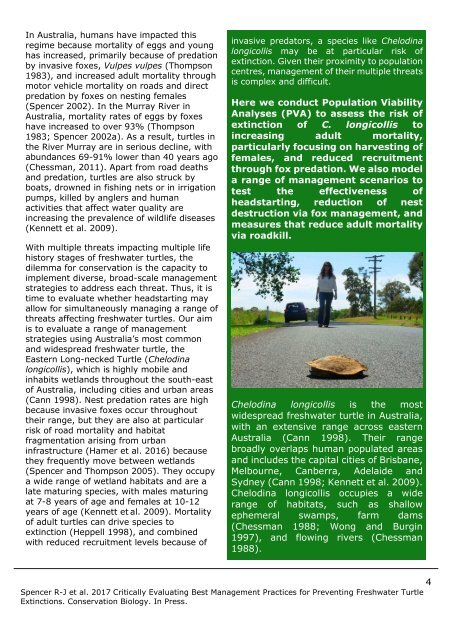Preventing Freshwater Turtle Extinctions
Critically Evaluating Best Management Practices For Preventing Freshwater Turtle Extinctions
Critically Evaluating Best Management Practices For Preventing Freshwater Turtle Extinctions
- No tags were found...
Create successful ePaper yourself
Turn your PDF publications into a flip-book with our unique Google optimized e-Paper software.
In Australia, humans have impacted this<br />
regime because mortality of eggs and young<br />
has increased, primarily because of predation<br />
by invasive foxes, Vulpes vulpes (Thompson<br />
1983), and increased adult mortality through<br />
motor vehicle mortality on roads and direct<br />
predation by foxes on nesting females<br />
(Spencer 2002). In the Murray River in<br />
Australia, mortality rates of eggs by foxes<br />
have increased to over 93% (Thompson<br />
1983; Spencer 2002a). As a result, turtles in<br />
the River Murray are in serious decline, with<br />
abundances 69-91% lower than 40 years ago<br />
(Chessman, 2011). Apart from road deaths<br />
and predation, turtles are also struck by<br />
boats, drowned in fishing nets or in irrigation<br />
pumps, killed by anglers and human<br />
activities that affect water quality are<br />
increasing the prevalence of wildlife diseases<br />
(Kennett et al. 2009).<br />
With multiple threats impacting multiple life<br />
history stages of freshwater turtles, the<br />
dilemma for conservation is the capacity to<br />
implement diverse, broad-scale management<br />
strategies to address each threat. Thus, it is<br />
time to evaluate whether headstarting may<br />
allow for simultaneously managing a range of<br />
threats affecting freshwater turtles. Our aim<br />
is to evaluate a range of management<br />
strategies using Australia’s most common<br />
and widespread freshwater turtle, the<br />
Eastern Long-necked <strong>Turtle</strong> (Chelodina<br />
longicollis), which is highly mobile and<br />
inhabits wetlands throughout the south-east<br />
of Australia, including cities and urban areas<br />
(Cann 1998). Nest predation rates are high<br />
because invasive foxes occur throughout<br />
their range, but they are also at particular<br />
risk of road mortality and habitat<br />
fragmentation arising from urban<br />
infrastructure (Hamer et al. 2016) because<br />
they frequently move between wetlands<br />
(Spencer and Thompson 2005). They occupy<br />
a wide range of wetland habitats and are a<br />
late maturing species, with males maturing<br />
at 7-8 years of age and females at 10-12<br />
years of age (Kennett et al. 2009). Mortality<br />
of adult turtles can drive species to<br />
extinction (Heppell 1998), and combined<br />
with reduced recruitment levels because of<br />
invasive predators, a species like Chelodina<br />
longicollis may be at particular risk of<br />
extinction. Given their proximity to population<br />
centres, management of their multiple threats<br />
is complex and difficult.<br />
Here we conduct Population Viability<br />
Analyses (PVA) to assess the risk of<br />
extinction of C. longicollis to<br />
increasing adult mortality,<br />
particularly focusing on harvesting of<br />
females, and reduced recruitment<br />
through fox predation. We also model<br />
a range of management scenarios to<br />
test the effectiveness of<br />
headstarting, reduction of nest<br />
destruction via fox management, and<br />
measures that reduce adult mortality<br />
via roadkill.<br />
Chelodina longicollis is the most<br />
widespread freshwater turtle in Australia,<br />
with an extensive range across eastern<br />
Australia (Cann 1998). Their range<br />
broadly overlaps human populated areas<br />
and includes the capital cities of Brisbane,<br />
Melbourne, Canberra, Adelaide and<br />
Sydney (Cann 1998; Kennett et al. 2009).<br />
Chelodina longicollis occupies a wide<br />
range of habitats, such as shallow<br />
ephemeral swamps, farm dams<br />
(Chessman 1988; Wong and Burgin<br />
1997), and flowing rivers (Chessman<br />
1988).<br />
4<br />
Spencer R-J et al. 2017 Critically Evaluating Best Management Practices for <strong>Preventing</strong> <strong>Freshwater</strong> <strong>Turtle</strong><br />
<strong>Extinctions</strong>. Conservation Biology. In Press.


